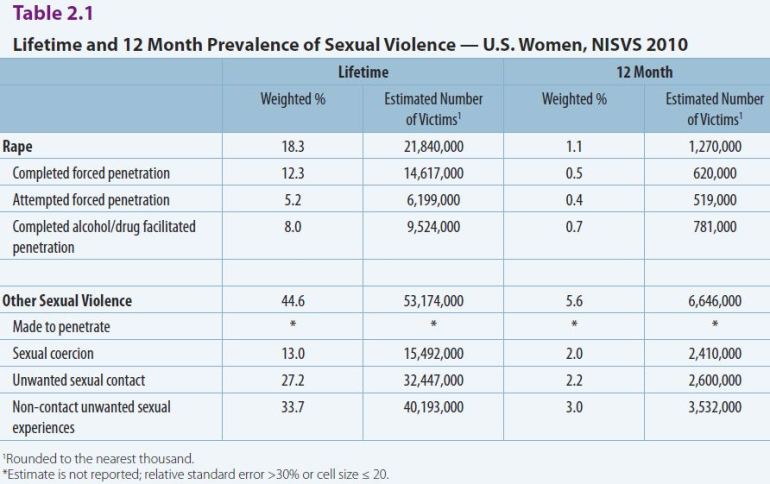
Christina Sommers, who works out of the American Enterprise Institute (along with Brad Wilcox and Charles Murray), thinks the Centers for Disease Control, President Obama, and the feminist establishment are exaggerating how much rape there is. I’m not an expert on measuring rape – and neither is she – but I’ve looked into it enough to say her debunking is basically bunk.
Then: What happens when we go beyond her argument?
Lifetime experience of rape
In a video put out for the American Enterprise Institute, under the misnom de guerre “Factual Feminist,” Sommers quotes Obama as saying, “one in five women will be a victim of rape in their lifetime.” I’m mostly going to focus on this empirical claim.
Obama gets that statistic from the 2010 National Intimate Partner and Sexual Violence Survey, conducted by the CDC (he says it like it’s a projection, but it’s just a cross-sectional lifetime prevalence estimate). Sommers complains that the NIPSVS finds a higher rate of rape than the National Crime Victimization Survey, which she asserts is the gold standard in this area. She says:
By using a non-representative sample, and vaguely-worded questions, the CDC yielded the one-in-five lifetime rate, and the 1.3 million female rape victims per year.
The NIPSVS reported that 18.3% of women had ever been the victim of rape, comprising three (non-exclusive) components: completed forced penetration, attempted forced penetration, or completed alcohol or drug facilitated penetration. Here is their table (click to enlarge):
Sommers claims the CDC has too broad a definition of rape, including lots of namby-pamby complaints from women brainwashed by the victimhood-obsessed feminist establishment.
So the most important point in response to that is that the lifetime reported rape rate in the NIPSVS is actually pretty low. The CDC’s other major survey, the National Survey of Family Growth, in 2002 found that 22.6% of women in the ages 18-44 had ever been forced to have intercourse (the last time they asked these questions). This is surprising because the NIPSVS measure is broader: it includes attempted rape as well as oral or anal penetration, and penetration by objects other than a man’s penis, including acts performed by women. The NSFG asked only about vaginal intercourse by a man. So the NIPSVS has a broader definition and finds a lower rate of lifetime rape prevalence. Given the difficulties in defining and measuring these experiences, this seems within the realm of reasonable.
Sommers’ only specific complaint about the NIPSVS rape prevalence statistic is that they include alcohol or drug facilitated penetration. To make this point she engages in a misleading rant about sex under the influence of alcohol and drugs, not exactly misstating the NIPSVS method but carefully not describing it accurately. “What about sex while inebriated?” she asks. “Few people would say that sex while intoxicated alone constitutes rape.” Right, and neither does the NIPSVS. The survey asked, “When you were drunk, high, drugged, or passed out and unable to consent, how many people ever…” and then it lists various kinds of penetration. The key phrase there is and unable to consent. They are not saying all drunk or drugged sex is rape.
She also claims that the NIPSVS is unrepresentative because it had a low response rate of about 30%. That’s life in the big city of surveys these days, and they attempted to compensate for it by using a weighting scheme to make the data representative of the national population. It’s not ideal but it’s not terrible, and that just means it should be interpreted cautiously and corroborated – neither Sommers nor I have any reason to believe this contributes to an inflated estimate of rape prevalence (though of course that’s possible).
In summary: If you have to pick a number to put to the lifetime prevalence of rape, I don’t think “one-in-five” is an unreasonable choice.
What is rape
The NSFG survey, which arrived at a higher lifetime rape rate, combined two sets of responses to reach 22.6% for it’s 18-44 year-old respondents. These questions were in the self-administered portion of the survey due to the sensitivity of the topic. In one part of the survey they asked, simply, “At any time in your life, have you ever been forced by a male to have vaginal intercourse against your will?” In another part they asked a two-part question. First:
Think back to the very first time you had vaginal intercourse with a male. Which would you say comes closest to describing how much you wanted that first vaginal intercourse to happen?
- I really didn’t want it to happen at the time
- I had mixed feelings—part of me wanted it to happen at the time and part of me didn’t
- I really wanted it to happen at the time.
And then, this followup:
Would you say then that this first vaginal intercourse was voluntary or not voluntary, that is, did you choose to have sex of your own free will or not?
If the respondents said it was not voluntary, that counted as ever having forced sex. This is not a criminal definition of rape. Rather, it identifies people who had sex involuntarily — from their perspective. It is understandable that this measure produces higher estimates than the criminal law does.
Naming violence
I think we need a definition of rape that is not the same as the criminal law’s definition, because the law is not intended to make criminal all of the ways that people experience sexual violation or coercion. The routine coercion of sex within unequal marriages, for example, must lie outside the reach of criminal law — or the next thing you know we’d have workers claiming that their employers’ profits constitute theft. In that sense, the definition used by NSFG seems reasonable.
Extending this further, however, we might find that drawing the line between sex and violence, between sex and rape, my not just be difficult, it may the wrong question.
Look back at the NIPSVS. They include “sexual coercion” under the category of “other sexual violence” — other meaning not rising to the level of rape. (To be clear, this is not part of the rape prevalence estimates I discussed above). They offer this definition:
Sexual coercion is defined as unwanted sexual penetration that occurs after a person is pressured in a nonphysical way. In NISVS, sexual coercion refers to unwanted vaginal, oral, or anal sex after being pressured in ways that included being worn down by someone who repeatedly asked for sex or showed they were unhappy; feeling pressured by being lied to, being told promises that were untrue, having someone threaten to end a relationship or spread rumors; and sexual pressure due to someone using their influence or authority.
Sommers is incensed this counts as “violence.” Her voice drips with contempt as she recites the description, at how feminism’s pretty little flowers are upset that somebody lied to them. I don’t share this contempt. But neither would I insist that these forms of coercion be counted as “violence.” Sexual coercion does not have to be defined as violence in order to be important, or bad, or an essential element of many people’s sexual experience.
You can’t handle the truth?
The feminist argument for the distinction between sex and violence is partly a defense of “normal” sexual relationships and against the accusation that it is normal sexual relationships that feminists oppose. This is exactly the tone Sommers takes: feminists treat women as passive victims who can’t handle normal relationships — you can’t even get drunk and have sex with your spouse anymore! Arguing with her over the definition of violence is a losing battle. I’ll give up “violence” if you agree that sexual coercion is systematically related to patriarchal power and gender inequality.
Here’s an excerpt from Catharine MacKinnon’s old discussion of rape versus sex (from the 1981 essay, “Sex and Violence,” published in the collection Feminism Unmodified), which influenced my attitude on this question. She said it is…
…potentially cooptive [to formulate the question as] these are issues of violence, not sex: rape is a crime of violence, not sexuality… I hear in the formulation that these issues are violence against women, not sex, that we are in the shadow of Freud, intimidated at being called repressive Victorians. We’re saying we’re oppressed and they say we’re repressed. That is, when we say we’re against rape the immediate response is, “Does that mean you’re against sex?” “Are you attempting to impose neo-Victorian prudery on sexual expression?” … To distinguish ourselves from this, and in reaction to it, we call these abuses violence.
To argue with Sommers about where to draw the line for sexual violence is to inhabit the shadow of Freud, in MacKinnon’s view. Rather than adopt that defensive posture, MacKinnon argued, feminists should own women’s fundamental, non-objective (in the sense of disinterested) position:
We have a deeper critique of what has been done to women’s sexuality and who controls access to it. What we are saying is that sexuality in exactly these normal forms often does violate us. So long as we say that those things are abuses of violence, not sex, we fail to criticize what has been made of sex, what has been done to us through sex, because we leave the line between rape and intercourse … right where it is.
In other words, if feminists argue over whether women’s perception of involuntary sex matches the legal definition, then we lose the ability to explain that unequal sex is systematic rather than deviant. It may not be that one-in-five women has experienced rape according to the definition within criminal law (though that is certainly within the realm of possible). But if that many women have had sex involuntarily, and many more have experienced sexual coercion of various kinds, isn’t that bad enough?



Reblogged this on iheariseeilearn.
LikeLike
Very helpful piece, thank you.
LikeLike
Reblogged this on dariancase.
LikeLike
“But if that many women have had sex involuntarily, and many more have experienced sexual coercion of various kinds, isn’t that bad enough?”
This is what drives me nuts about this blogger. You spend an extraordinary amount of time taking down C.Sommers on debunking rape stats. Howver, ly you have no evidence of one-in-five either by legal or some made up definition. Then why end the essay with nonsense. I contend that ” that one-in-five women has experienced rape according to the definition within criminal law ” is not even true even you replace the definition by your made up definition.
I sincerely despise the chorus of academic cheerleaders who have responded with aye on the comments. What are you saying that this blogger has shown in response.
LikeLiked by 1 person
I guess the alternative is to only count rapes according to convictions in criminal trials. Why use surveys at all?
LikeLike
you are welcome to conclusions based on data. The entire section under “You cant handle the truth” is crap and thrown in as a sop to fellow-travelers.
Again, I summarize my objections; As a an academic, if you cannot call bullshit on made-up one-in-five numbers, you should let those who do live. Instead you take your sword at those who do.
LikeLike
The “only alternative” really? Your narrow mindedness in that reply validates “vijay”. Thanks for that.
LikeLike
The purpose of the essay was to “go beyond the argument”. CMIIW but it sounds like the author is saying the same thing I’ve been saying — that this doesn’t revolve around a statistic.
LikeLike
This is a very well reasoned discussion, thank you.
LikeLike
Reblogged this on The Life Of Von and commented:
What we need is not more definitions but paradigm shifts in attitudes to violence towards women and girls. If we see rape as an act of violence along with other acts of violence the stats are more like 1:4 or 1:3, maybe more in some communities. It’s time more men stood up against violence by other men against women. The first have bravely begun. Let it continue until it becomes the norm.
LikeLike
There has to be a happy median between being “in the shadow of” Freud and ignoring him completely. When Freud spoke of id and superego, he wasn’t talking about systems of humanity. He was talking about parts of an individual’s mind. Everyone has an id and a superego, even if they aren’t the same things Freud thought they are. Cases of literal sexual violence are not intended as sex, and are comparatively rare. In most cases, a man considers himself to be having sex, so his superego is turned off. So the male-dominant pseudo-morality he might have picked up from culture is not a factor. The messages he may be under the influence of are those that describe the physical act of sex inequitably. American society typically calls these messages obscene and tries to censor them. That will never work. The messages must be counteracted from within their own physical context, in ways that speak directly to the reader’s id. We as a nation need to get over our prudish fear of speaking at this level.
LikeLike
“n NISVS, sexual coercion refers to unwanted vaginal, oral, or anal sex after being pressured in ways that included being worn down by someone who repeatedly asked for sex or showed they were unhappy; feeling pressured by being lied to, being told promises that were untrue, having someone threaten to end a relationship”
With this definition, 90% of men would be rapists and 70% of sexual acts would be rape. So i Recommend sex be classified as violence to women, in general.
LikeLike
You are making Catharine MacKinnon’s point. I agree that she’s probably right.
LikeLike
I am making the opposite of Chatherine Mackinnon’s point. Does she know what violence or repression mean(s)? It would be truly hard to characterize any problems of women in the first world as repression.
Her critique of Marx is a laughable parody.
LikeLike
I would delete this comment for obnoxiousness, but it’s a good example of someone knowing little thinking they know more than someone who knows a lot (mansplaining MacKinnon). If you spell her name correctly you can look it up: https://en.wikipedia.org/wiki/Catharine_MacKinnon
LikeLike
No it isn’t. It’s an example of a teachable moment. By considering vijay a know-it-all instead of a confused questioner, you threw that moment away.
LikeLike
Then look up the Dunning-Kruger effect: http://en.wikipedia.org/wiki/Dunning%E2%80%93Kruger_effect
LikeLike
If one were aware of statistical probability, there should be no argument. The top 20% of a population have 80% of the frequency, meaning if the most sexually active people have some form of sex daily, how can you be surprised that at some single instance, it was nonconsensual?
LikeLike
I’ve been tracking public responses to the “one in five” statistic pretty closely for the past couple of months. On the one hand, some people disagree with any expanded definition of rape that goes beyond strangers using physical force. That strategy is a loser. Second wave feminists won that battle long ago. There are some holdouts, but I think the wider public gets it. However, a small circle of backlashers have been embracing the expanded definition of sexual assault as a means to argue that men have it just as bad. Look at the NISVS category for “made to penetrate” (which doesn’t show any number in the table you cite above because it was only used in the questionnaire for men). Some groups cite this figure to show men are victimized just as much as women (here is an example: http://www.slate.com/articles/double_x/doublex/2014/04/male_rape_in_america_a_new_study_reveals_that_men_are_sexually_assaulted.html). However, this new strategy is undercut by folks like Sommers who would likely dismiss the “made to penetrate” category as ridiculous. They can’t have it both ways. Their inconsistency in attacks against the “one in five” statistics creates so much static that it renders their political message incoherent.
LikeLike
You missed the part where she explains the surveyor gets to decide if the surveyed was raped. Which is the same flaw in all of these “measurements”.
You will never ascertain an answer so long as the humans conducting the research are part of the variables.
Are some women raped that don’t think they were? Possibly, especially in cases of severe abuse. Is a brief phone conversation enough to determine this? Of course not.
Has anyone ever lied about being a rape victim or do people ever lie when being polled? Can people be conditioned through the way you ask questions to generate answers you want? Yes, of course.
There is no way to even determine how many false cases there could be which removes your ability to have any sort of proper error tracking.
So Sommers is both right and wrong. The simple fact is this is an unknowable, unknown and in such cases you cannot really innovate solutions (the major flaw in sociology itself).
Even if there was factual accuracy, the CDC could not conclude the circumstances of each individual rape through an impromptu interview and thus really cannot be in an intellectually honest position to suggest remedies.
My advice is for you to examine polls that news agencies throw out and how those polls can be utterly contradictory.
Another factor is that no one seems to be including or examining data of actual crime statistics and number of reported incidents per year. Nor has a longitudal study of each victim been attempted.
Before I get harped on – no, this isn’t rape apology. This is trying to demonstrate how you have no real way to ascertain the truth because of the one variable you cannot isolate – humans. Thus using it either in positive or negative light is ridiculous and since it may not be factually correct – policies adopted based on factually inaccurate conclusions, can have serious consequences the worst of which is that rape keeps going on.
LikeLike